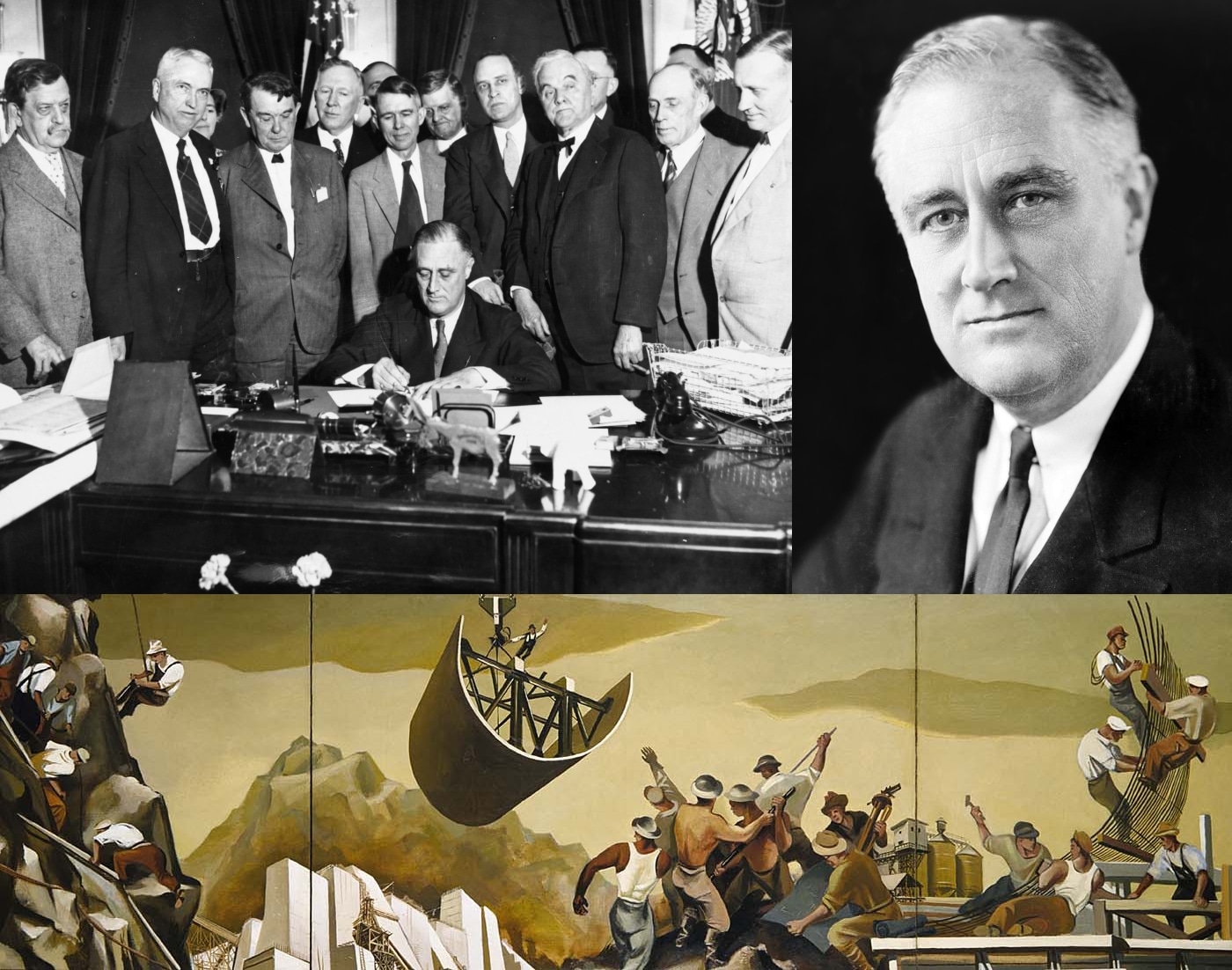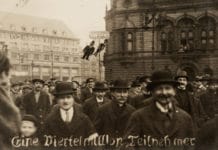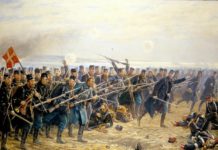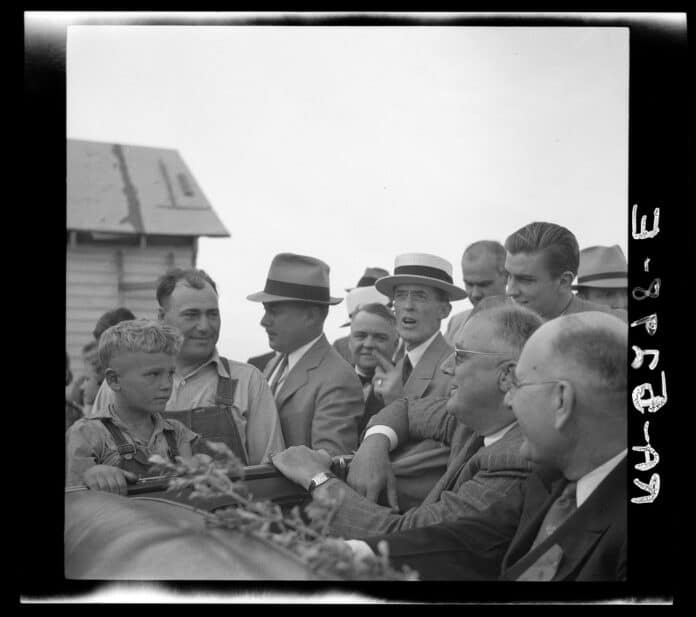
Om krisen i 30’erne i USA og præsident Franklin D. Roosevelts forsøg på at standse krisen med omfattende beskæftigelsesarbejder kaldet “New Deal”.
Se også på Socialistisk Bibliotek:
- Linkboxen: Wall Street krisen 1929
Den 25. oktober 1929 oplevede børsen i Wall Street, New York, et børskrak – ’Den Sorte Torsdag’. - Linkboxen: Arbejdskampe i USA i 1930’erne / Worker’s struggles in the US during the 1930’s

Leksikale:
- New Deal (Leksikon.org)
- New Deal (Denstoredanske)
- New Deal (Wikipedia.dk) + New Deal (Wikipedia.org)
- Glossary of events: New Deal (Marxists Internet Archive)
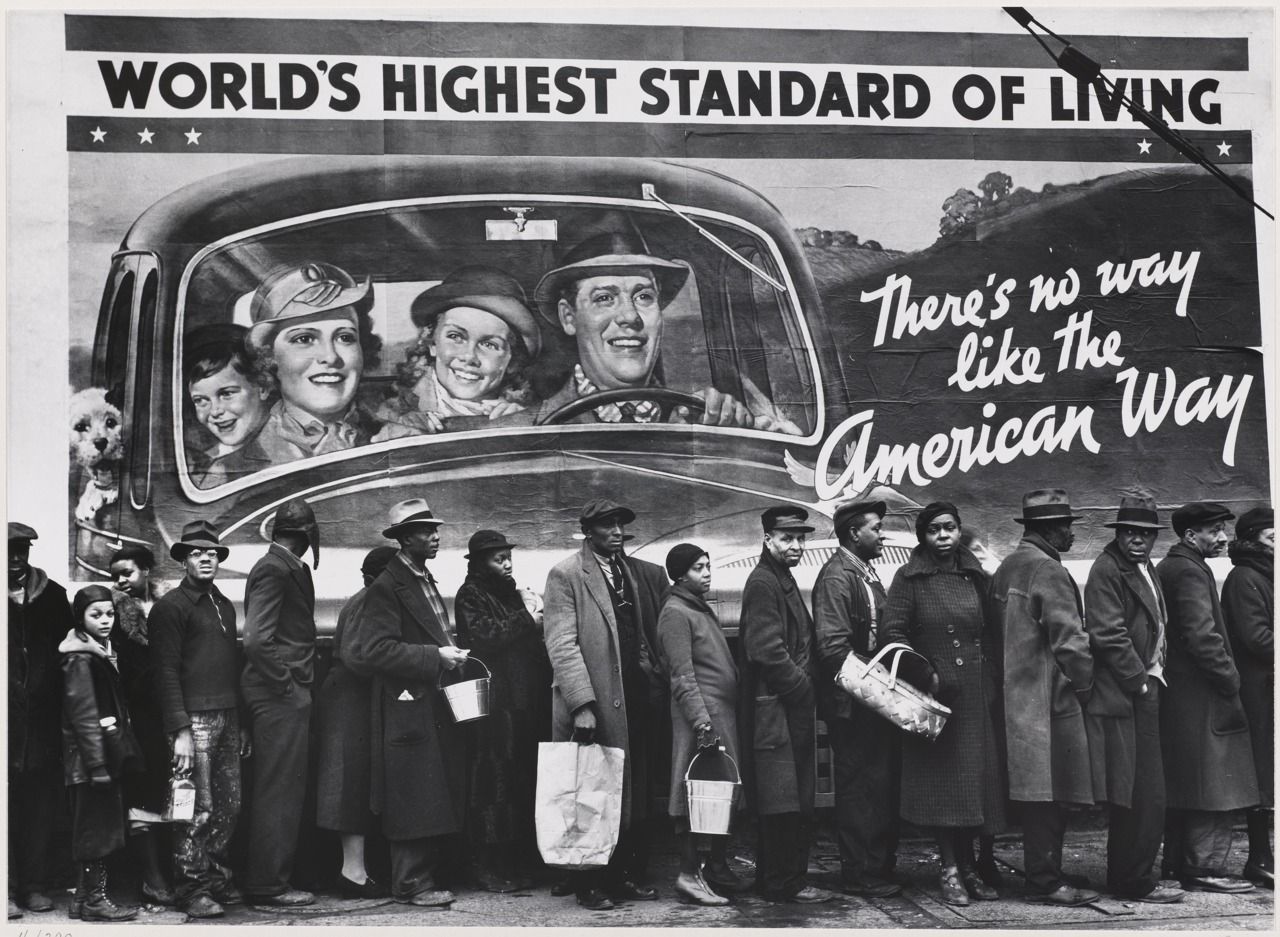
Artikler:
The Red Scare deformed the New Deal by purging its radical civil servants. By Nick French (Jacobin, January 17, 2023)
“The New Deal brought a generation of leftists into the federal government. But Red Scare anti-communists purged these radical bureaucrats or forced their politics rightward — blocking more far-reaching reform and distorting our understanding of the New Deal.”
Worker insurgency and the New Deal (Tempest, December 20, 2022)
“Kim Moody interrogates Eric Blanc’s account of the relationship between the Democrats and working-class self-activity in the New Deal era.”
See also Kim Moody: Worker insurgency and the New Deal: “Explaining” strikes for union recognition (Ibid., December 20, 2022)
How FDR’s original Green New Deal challenged Jim Crow. By Paul J. Baicich and Richard A. Walker (Jacobin, September 25, 2021)
“The Civilian Conservation Corps, FDR’s original Green New Deal, cared for the environment and gave jobs to the unemployed. And though its record on racial equality was imperfect, it helped undermine key parts of Jim Crow.”
What the New Deal can teach us about winning a Green New Deal. Part 5: Summing up the New Deal experience. By Marty Hart-Landsberg (Reports from the Economic Front, Blog, October 13, 2019)
“My aim in this series, including in this fifth and last post, is to illuminate the challenges faced and choices made by these activists in order to draw out some of the relevant lessons.”
See also:
Part 1: Confronting crisis (August 2, 2019)
Part 2: Movement building (August 13, 2019)
Part 3: The first New Deal (August 24, 2019)
Part 4: Keeping the pressure on the state (September 20, 2019)
Lessons from World War II: The Green New Deal & the State. By Martin Hart-Landsberg (Against the Current, Issue 207, July-August 2020). “In this article I draw on the experience of World War II when the state was forced to direct a rapid transformation from civilian to military production to help encourage and concretize that discussion.”
The New Deal in the American political imagination. By Steve Fraser (Jacobin, 30 June 2019)
“The New Deal solidified capitalist democracy in the United States. The country has swung between hints of social democracy and free market absolutism ever since.”
What the New Deal can teach us about a Green New Deal: An interview with Richard Walker (Jacobin, March 26, 2019)
“The original New Deal was a bold, visionary effort that transformed the economic and political life of the country. The Green New Deal could do even more.”
Building a “Green New Deal”: Lessons from the original New Deal (Verso, Blog, 19 November 2018)
“Demands centering on the need for a ‘Green New Deal’, focused on the creation of a public works ‘green jobs’ infrastructure policy, have helped energise the American left in recent weeks. In this article Matt Huber offers four vital lessons from the original New Deal that contemporary activists and policymakers must learn.”
The New Deal and the Popular Front: Models for contemporary socialists? By Charlie Post (International Socialist Review, Issue 108, Spring 2018)
“This essay suggests that Sanders’s admiration for the New Deal, and Schwartz and Sunkara’s embrace of the popular-front strategy are based on an idealized history of both the Roosevelt administration and the Communist Party’s politics.”
75 years ago: Roosevelt warns of civil war in America (World Socialist Web Site, This Week in History, 27 February 2012)
“In the midst of the sit-down strike wave … Roosevelt drew historical comparisons to the American Civil War …”
Preliminary notes on the New Deal. By Louis Proyect (The Unrepentant Marxist, November 9, 2011)
“I believe that it is absolutely necessary for the left to take on New Deal mythology and smash it once and for all. As is the case with Kemalism in Turkey and the PRI in Mexico, FDR’s liberalism is a kind of foundational myth for our own powerful bourgeois party crafted in progressive terms.”
The unemployed movement of the 1930s: Bringing misery out of hiding . By Danny Lucia (International Socialist Review, Issue 71, May–June 2010)
“This year marks the seventy-fifth anniversary of the passage of the Social Security Act (SSA). The SSA, which created unemployment insurance and assistance programs for the elderly, disabled, and poor, is the most lasting achievement of Franklin Delano Roosevelt’s New Deal.”
The illusion of a New Deal for today. By Phil Sharpe (A World to Win, January 2010). Review of Nancy E Rose, Put to Work: The WPA and Public Employment in the Great Depression (Monthly Review Press, 2009)
“Phil Sharpe differs with Nancy Rose’s assessment of US government relief projects in the 1930s. He argues that the American working class cannot rely on a renewal of the New Deal to introduce anti-capitalist policies.”
Lessons from the New Deal public employment programs. By Nancy E. Rose (Monthly Review, October 2009). The concluding chapter of the new edition of Nancy Rose’s Put to Work (Monthly Review Press, 1993/2009)
1934: year of the fightback (International Socialism, Issue 122, Spring 2009)
“John Newsinger look at how workers fought back in the face of vicious attacks by employers and the state, and despite initially weak trade unions.”
Do we need a new ‘New Deal’? By Sean Collins (Spiked Review of Books, Issue 24, May 2009)
“Whatever conventional wisdom tells us, it isn’t true that Franklin Delano Roosevelt’s New Deal brought the Great Depression of the 1930s to an end.”
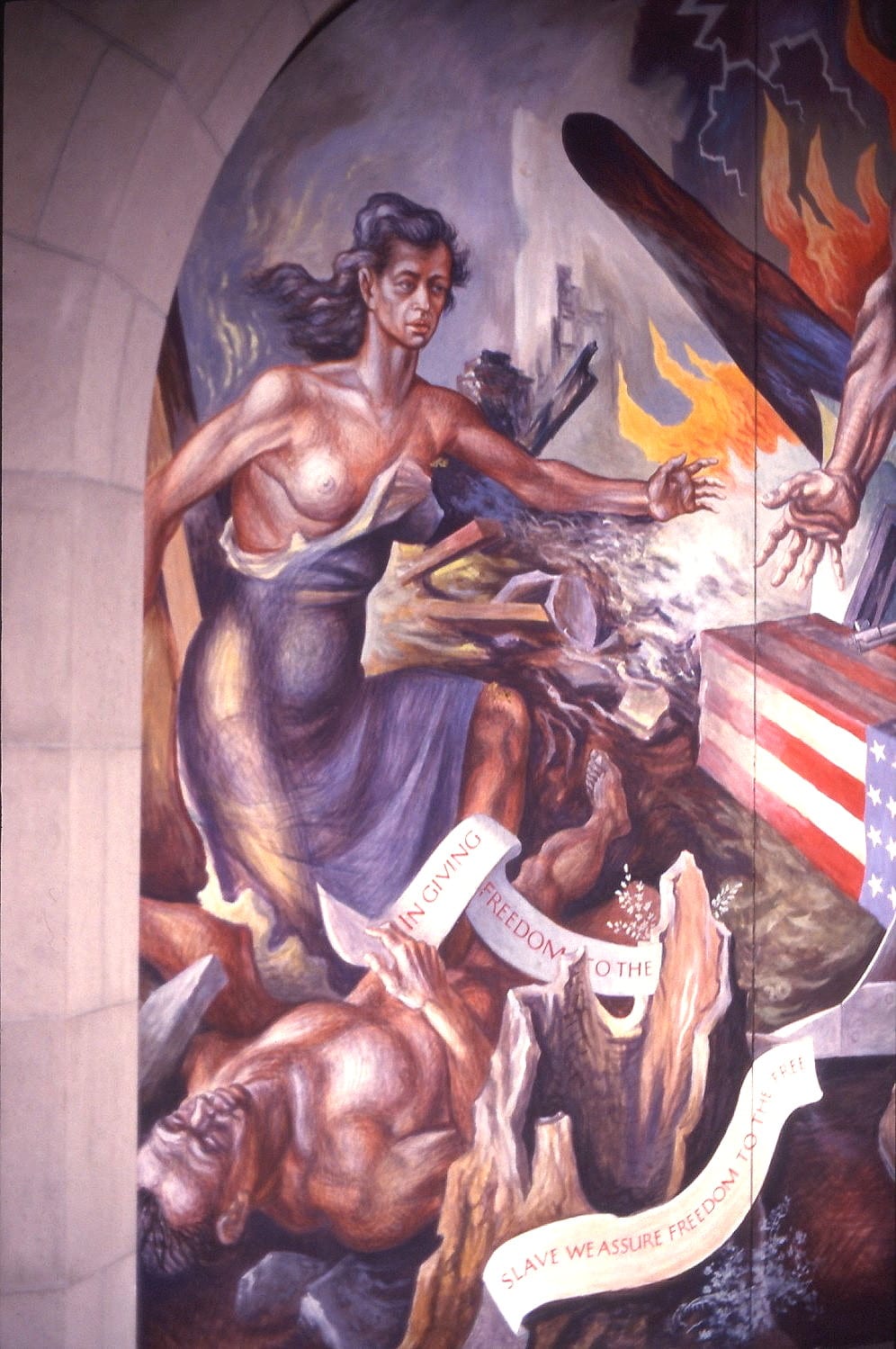
A new New Deal under Obama? By John Bellamy Foster and Robert W. McChesney (Monthly Review, Vol.60, No.9, February 2009)
“The New Deal was not initially an attempt to stimulate the economy and generate recovery through government spending, an idea that was scarcely present in the early 1930s. Rather it consisted of ad hoc salvage or bailout measures …”
Was the ‘New Deal’ a good deal? By Chris Harman (Socialist Review, Issue 332, January 2009)
“It is accepted wisdom that President Franklin D Roosevelt pulled the US out of the Depression with the New Deal. But in reality there were numerous forces at play.” På dansk: Var ‘New Deal’ en god deal? (Socialistisk Arbejderavis, nr.285, 17. januar 2009).
The Roosevelt New Deal myth (Solidarity, 3/143, 4 December 2008)
“The Roosevelt myth – that he was a great progressive or some sort of friend of labour – remains one of the most pernicious in history. Yet it hardly stands up to a cursory examination of the evidence.”
Who made the New Deal? (SocialistWorker.org, November 14, 2008)
“Lance Selfa recounts the history of an era that is still remembered for the important changes that benefited the working majority.”
Did the ’New Deal’ benefit US workers? (Socialist Worker, Issue 2124, 25 October 2008)
“Attempts to kick start the economy during the Great Depression remain for many an example of how the state should intervene. But, says Jonny Jones, the plan offered no solution for the poor.”
Confronting the economic crisis: The New Deal at 75 – lessons for today. By Dan La Botz (MR Online, April 8, 2008)
“Some believe that Roosevelt’s New Deal ended the Great Depression, but that was not the case. Roosevelt only brought the country out of the depression by leading the US into war.”
Roosevelt’s double edged New Deal. By Nigel Davey (Socialist Worker, Issue 2095, 5 April 2008)
“Franklin Roosevelt proposed policies similar to what we today call Keynesianism – favouring a powerful, centralised government that intervenes in markets and plans the economy.”
Are we going back to the 1930s? A decade of political polarisation (Socialist Worker, Issue 2094, 29 March 2008)
“Matthew Cookson looks at the decade of economic turmoil and political polarisation.”
The Great Depression and the New Deal. Chapter 6 in Paul Mattick: Economics, politics and the age of inflation (M. E. Sharpe, 1978, 143 p.)
“The Keynesian theory found no verification in the New Deal. The depression was finally ended not by a new prosperity but through World War II, that is, through the colossal destruction of capital on a worldwide scale and a restructuring of the world economy that assured the profitable expansion of capital for another period.”
The myth of the New Deal. In: A new history of Leviathan. Edited by Ronald Radosh and Murray N. Rothbard (New York, 1972, p.146-187; online at Marxmail.org/Internet Archive)
“The New Deal was conservative. Its special form of conservatism was the development of reforms that modernized corporate capitalism and brought corporate law to reflect the system’s changed nature.”
Ten years of the New Deal. By George Novack (Fourth International, Vol.4, No.3, March 1943)
“Roosevelt’s regime will go down in history as the regime of most grandiloquent pretensions and most abysmal failures.”
Roosevelt faces the future. By James Burnham (New International, Vol.4, No.2, February 1938)
“Not only does Roosevelt understand clearly his role as general representative of American imperialism; he knows too that a chief – perhaps the primary – task of the bourgeois politician is to keep the confidence of the masses in the bourgeois state and the capitalist order.”
See also:
The Coming of the American Behemoth. By Martin Hall (Counterfire, August 1, 2019). Review of Michael Joseph Roberto, The Coming of the American Behemoth: The Genesis of Fascism in the United States, 1920-1940 (Monthly Review Press 2018, 463 p.). “It is an achievement to present such a meticulously researched book dealing with theory, history and politics that also manages to be accessible to the reader trained in none of those disciplines.”
The dynamics of retreat (Jacobin: Reason in Revolt, Issue 20, Winter 2016). “Bhaskar Sunkara spoke to Robert Brenner, a professor of history at University of California Los Angeles, about the myths and realities of this often-romanticized period [of the New Deal].”
